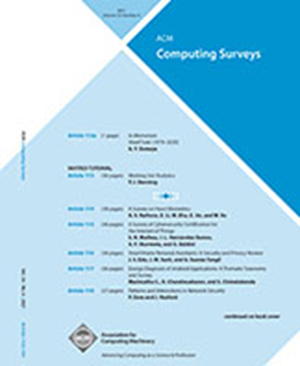A Survey on Kolmogorov-Arnold Network
IF 28
1区 计算机科学
Q1 COMPUTER SCIENCE, THEORY & METHODS
引用次数: 0
Abstract
This review study explores the theoretical foundations, evolution, applications, and future potential of Kolmogorov-Arnold Networks (KAN), a neural network model inspired by the Kolmogorov-Arnold representation theorem. KANs set themselves apart from traditional neural networks by employing learnable, spline-parameterized functions rather than fixed activation functions, allowing for flexible and interpretable representations of high-dimensional functions. The review explores Kan’s architectural strengths, including adaptive edge-based activation functions that enhance parameter efficiency and scalability across varied applications such as time series forecasting, computational biomedicine, and graph learning. Key advancements including Temporal-KAN (T-KAN), FastKAN, and Partial Differential Equation (PDE) KAN illustrate KAN’s growing applicability in dynamic environments, significantly improving interpretability, computational efficiency, and adaptability for complex function approximation tasks. Moreover, the paper discusses KANs integration with other architectures, such as convolutional, recurrent, and transformer-based models, showcasing its versatility in complementing established neural networks for tasks that require hybrid approaches. Despite its strengths, KAN faces computational challenges in high-dimensional and noisy data settings, sparking continued research into optimization strategies, regularization techniques, and hybrid models. This paper highlights KANs expanding role in modern neural architectures and outlines future directions to enhance its computational efficiency, interpretability, and scalability in data-intensive applications.关于Kolmogorov-Arnold网络的综述
本文综述了受Kolmogorov-Arnold表示定理启发的神经网络模型Kolmogorov-Arnold Networks (KAN)的理论基础、发展、应用和未来潜力。kan通过使用可学习的样条参数化函数而不是固定的激活函数,将自己与传统的神经网络区分开来,允许高维函数的灵活和可解释的表示。这篇综述探讨了Kan的架构优势,包括自适应的基于边缘的激活函数,它可以提高参数效率和可扩展性,适用于各种应用,如时间序列预测、计算生物医学和图学习。主要进展包括Temporal-KAN (T-KAN)、FastKAN和偏微分方程(PDE) KAN,说明KAN在动态环境中的适用性越来越强,显著提高了可解释性、计算效率和对复杂函数近似任务的适应性。此外,本文还讨论了KANs与其他架构的集成,例如卷积,循环和基于变压器的模型,展示了其在补充需要混合方法的任务中建立的神经网络的多功能性。尽管具有优势,但KAN在高维和噪声数据设置中面临计算挑战,这引发了对优化策略、正则化技术和混合模型的持续研究。本文强调了KANs在现代神经体系结构中的扩展作用,并概述了在数据密集型应用中提高其计算效率,可解释性和可扩展性的未来方向。
本文章由计算机程序翻译,如有差异,请以英文原文为准。
求助全文
约1分钟内获得全文
求助全文
来源期刊

ACM Computing Surveys
工程技术-计算机:理论方法
CiteScore
33.20
自引率
0.60%
发文量
372
审稿时长
12 months
期刊介绍:
ACM Computing Surveys is an academic journal that focuses on publishing surveys and tutorials on various areas of computing research and practice. The journal aims to provide comprehensive and easily understandable articles that guide readers through the literature and help them understand topics outside their specialties. In terms of impact, CSUR has a high reputation with a 2022 Impact Factor of 16.6. It is ranked 3rd out of 111 journals in the field of Computer Science Theory & Methods.
ACM Computing Surveys is indexed and abstracted in various services, including AI2 Semantic Scholar, Baidu, Clarivate/ISI: JCR, CNKI, DeepDyve, DTU, EBSCO: EDS/HOST, and IET Inspec, among others.
 求助内容:
求助内容: 应助结果提醒方式:
应助结果提醒方式:


